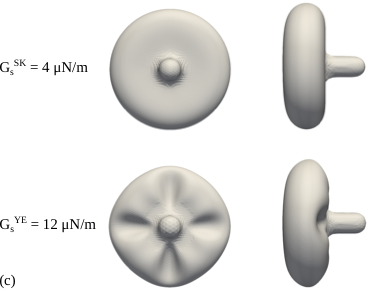Achievement: Three constitutive laws - the Skalak, neo-Hookean and Yeoh laws - commonly employed for describing the erythrocyte membrane mechanics are theoretically analyzed and numerically investigated to assess their accuracy for capturing erythrocyte deformation characteristics and morphology. Particular emphasis is given to the nonlinear deformation regime, where it is known that the discrepancies between constitutive laws are most prominent. Hence, the experiments of optical tweezers and micropipette aspiration are considered here, for which relationships between the individual shear elastic moduli of the constitutive laws can also be established through analysis of the tension-deformation relationship.
Significance and Impact: All constitutive laws were found to adequately predict the axial and transverse deformations of a red blood cell subjected to stretching with optical tweezers for a constant shear elastic modulus value. As opposed to Skalak law, the neo-Hookean and Yeoh laws replicated the erythrocyte membrane folding, that has been experimentally observed, with the trade-off off sustaining significant area variations. For the micropipette aspiration, the suction pressure-aspiration length relationship could be excellently predicted for a fixed shear elastic modulus value only when Yeoh law was considered. Importantly, the neo-Hookean and Yeoh laws reproduced the membrane wrinkling at suction pressures close to those experimentally measured. None of the constitutive laws suffered from membrane area compressibility in the micropipette aspiration case.
Research Details
- The experimental baselines were taken from micropipette aspiration and optical tweezing.
- Three common constitutive laws for the red blood cell cytoskeleton were evaluated – Skalak, neo-Hookean, and Yeoh.
- Simulations were conducted with a partitioned fluid-structure interaction approach based on the immersed boundary, lattice Boltzmann, and finite element methods.
Sponsor/Funding: NIH (at Duke), LDRD (at ORNL)
PI and affiliation: Amanda Randles, Duke University
Team: Marianna Pepona (Duke University / Durham University) , John Gounley (ORNL), Amanda Randles (Duke University)
Citation and DOI: M. Pepona, J. Gounley, A. Randles. Computers and Mathematics with Applications. Vol. 132, pages 145-160 (2023). DOI: https://doi.org/10.1016/j.camwa.2022.12.009

Summary: Simulations of red blood cells are important for a variety of biomedical applications, ranging from studies of blood diseases to the transport of circulating tumor cells. A particular challenge in conducting high-fidelity simulations is accurately modeling red blood cell deformation in the nonlinear regime. The present work provides insight into the range of applicability of the most commonly used constitutive laws in the modelling of the erythrocyte membrane response, that is the Skalak, neo-Hookean, and Yeoh laws. We have focused on the moderate and large deformation regime, which is commonly encountered also in physiological settings. The current study paves the way for further investigations on the effect of constitutive law on the erythrocyte behaviour. More physiologically relevant configurations, such as the flow of red blood cells through narrow slits similar to those encountered in the spleen, are worth exploring in the future.



